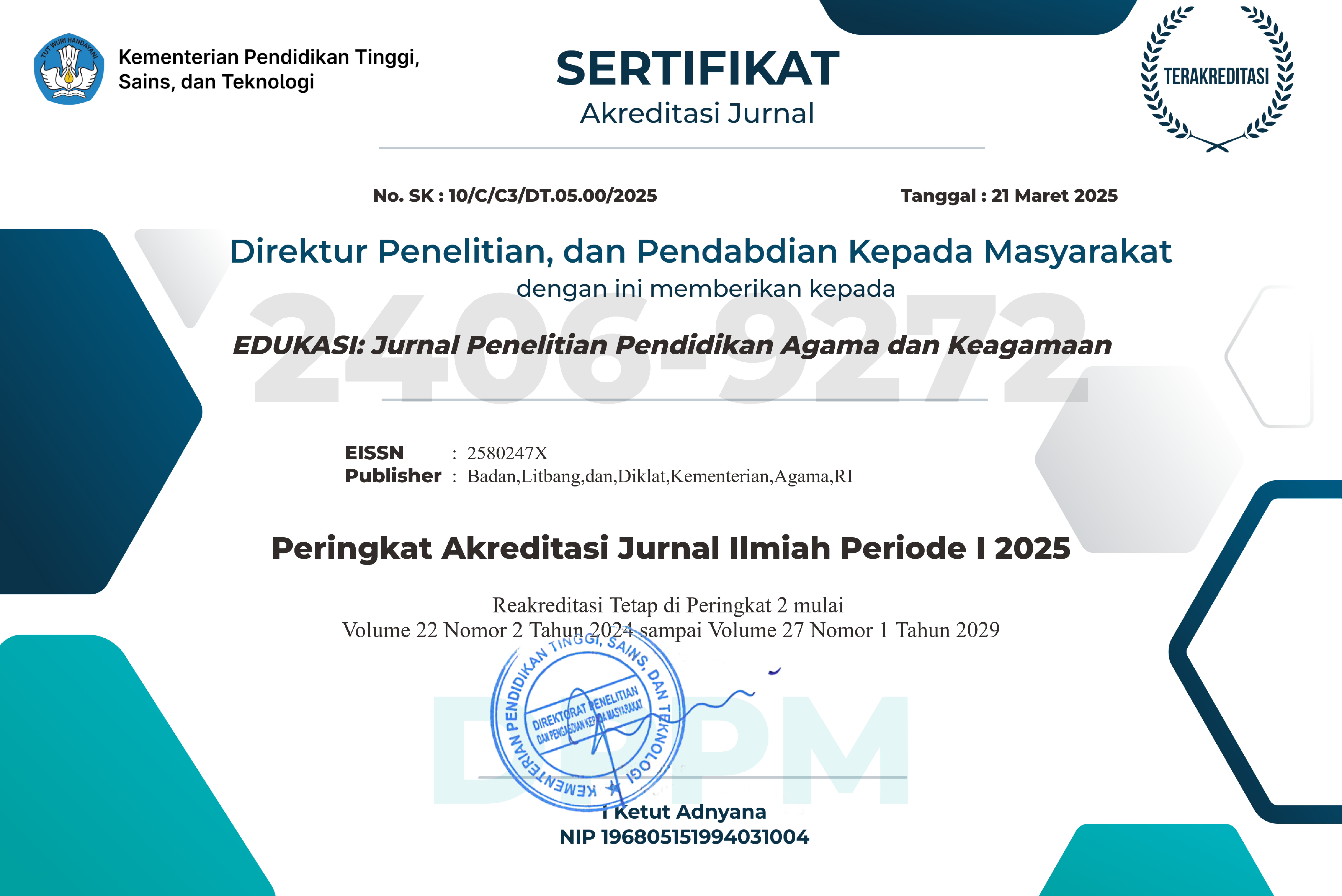KUALITAS KEPEMIMPINAN KEPALA MADRASAH PEREMPUAN DI LINGKUNGAN PONDOK PESANTREN
DOI:
https://doi.org/10.32729/edukasi.v17i1.541Keywords:
Creativity, Emotional maturity, Initiative, Perceptive, Responsibility, Inisiatif, Kedewasaan emosional, Kreativitas, Perseptif, Tanggung jawabAbstract
Abstract
This study is focused on efforts to assess quality and predict the leadership prospects of female madrasa leaders in pondok pesantren in West Lombok Regency. Using the qualitative-descriptive approach, the author seeks to express the quality of women's leadership based on perceptions, attitudes, and behaviors of some women in the position of head of the madrasa through interviews and observation. This study found that the leadership of female in madrasa can be categorized as having good quality. Based on the nine indicators used, there are seven indicators that appear in all research subjects, namely emotional maturity, objective, perceptive, adaptation, initiative, creativity, and communication skills. Responsibility indicators do not appear optimally in one subject of the study. Likewise, indicators of confidence. Women have good prospects to be in the leadership position because of quality. There is no significant rejection of female leaders, and there is no differentiation of opportunities for women and men to become leaders, as long as they have the ability.
Abstrak
Kajian ini difokuskan pada upaya menilai kualitas dan memprediksi prospek kepemimpinan kepala madrasah perempuan di pondok pesantren di Kabupaten Lombok Barat. Menggunakan pendekatan kualitatif-deskriptif, karena penulis berupaya mengungkapkan kualitas kepemimpinan perempuan berdasarkan persepsi, sikap, dan perilaku dari beberapa perempuan pada posisi jabatan kepala madrasah yang berada di lingkungan pondok pesantren, melalui wawancara dan observasi. Kajian ini menemukan bahwa Kepemimpinan kepala madrasah perempuan di pondok pesantren dapat dikategorikan memiliki kualitas yang cukup baik. Berdasarkan sembilan indikator yang digunakan, terdapat tujuh indikator yang muncul pada semua subjek penelitian yaitu kedewasaan emosional, objektif, perseptif, adaptasi, inisiatif, kreativitas, dan skill berkomunikasi. Indikator tanggungjawab tidak muncul secara maksimal pada satu subjek penelitian. Demikian juga indikator percaya diri. Perempuan memiliki prospek yang baik untuk berada di posisi pimpinan karena adanya kualitas. Tidak ada penolakan signifikan terhadap pemimpin perempuan, dan tidak ada pembedaan kesempatan bagi perempuan dan laki-laki untuk menjadi pemimpin, selama memiliki kemampuan.
Downloads
References
Anna G (2016) Gender Differences in Leaderships. Available at: https://www. researchgate.net/publication.
Bailey, S. (2014) Who Makes A Better: A Man or A Women. Available at: https://www.forbes.com (Accessed: 10 April 2017).
Bartholomew, J. R. (2000) Ali Lam Mim Kearifan Masyarakat Sasak. Edited by I. Rosyidi. Yogyakarta: Tiara Wacana.
Bush, Tony; Coleman, M. (2006) Leadership and Management in Education. Yogyakarta.
Downard, B. (2015) 101 Best Leadership Skills, Traits & Qualities – the Complete List. Available at: briandownard.com%3Eleadership.
Eagly, A. H. (2007) Female Leadership Advantage and Disadvantage Resolving the Contradiction.
Helgesen, S. (1995) The Female Advantage: Women Ways of Leadership. New York: Doubleday Dell Publishing Group, Inc. Available at: https://www.amazon.com.
Hesaje, H. (2013) ‘Female Leadership: An Exploratory Research from Lebanon’, American Journal of Scientific Research, (Issue 86 March, 2013).
Jirasinghe, D. G. L. (1996) The Competent Had: A Job Analysis of Heads Task Personality Fasctor. Amazon: Roudledge.
Luthans, F. (2006) Perilaku Organisasi. Yogyakarta: Andi.
Marshall, Catherine; Rossman, G. B. R. (1995) Designing Qualitative Research. 2nd ed. London: SAGE Publication.
Mufidah (2010) Bingkai Sosial Gender. Malang: UIN Malang Press.
Muflihin, M. H. (2018) ‘Kepemimpinan Pendidikan: Tinjauan terhadap Teori Sifat dan Tingkah-laku’, INSANIA : Jurnal Pemikiran Alternatif Kependidikan, 13(1), pp. 67–86. doi: 10.24090/insania.v13i1.286.
Murata, S. (1997) The Tao of Islam. Bandung: Mizan.
Nurhilaliati, N. (2018) Kepemimpinan Perempuan dalam Lembaga Pendidikan Islam (Studi Kasus pada Pondok Pesantren Al-Ikhlas Ranggo Pajo Dompu NTB).
Prive, T. (2015) Top Ten Qualities that Make A Great Leader. Available at: https://www.forbes.com.
Shanmugam, Menaha; Amaratunga, R.D.G; Haigh, R. P. (no date) Leadership Styles: Gender Similarities, Differnces and Perceptions. Available at: https://www.irbnet.de/daten/iconda.
Siagian, S. P. (1999) Teori dan Praktek Kepemimpinan. Jakarta: Rineka Cipta.
Stainback, S. S. (1988) Understanding & Conducting Qualitative Research. Virginia: Kendall/Huns.
Sugiyono (2010) Metode Penelitian Pendidikan: Pendekatan Kuantitatif, Kualitatif dan R&D.
Suralaga, F. (2003) ‘“Pendahuluanâ€â€™, in Pengantar Kajian Gender. Jakarta: PSW IAIN Syahid Kerjasama dengan McGill Project/IIESP.
Syafruddin (2013) Perceraian Orang Sasak (Dimensi Sosial Budaya). Mataram: IKIP Press.
Tracy, B. (2016) The Seven Leadership Qualities of All Great Leader. Available at: https://www.entrepreneur.com.
Tracy, B. (no date) The Seven Leadership Qualities of Good Leadership. Available at: https://www.briantracy.com.
Veithzal Rivai, A. A. (2009) Islamic Leadership: Membangun Super Leadership melalui Kecerdasan Spiritual.
Wahid, A. (2010) Menggerakkan Tradisi. Yogyakarta: LKiS.
Whitemore, J. (2015) Seven Qualities that Distinguish Genuine Leaders from Bossy Poseurs. Available at: https://www.entrepreneurship.com.
Wirawan, S. (2010) Pengantar Psikologi Umum. Jakarta: Raja Grafindo Persada.









